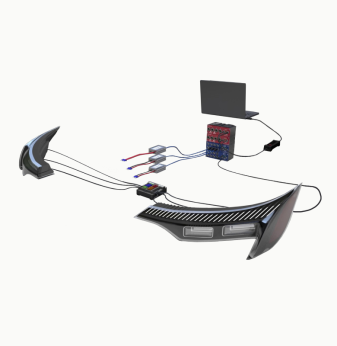Choosing an RTOS for Your Device: Comparing FreeRTOS, Zephyr, ThreadX, and More

Getting Started: Why RTOS Selection Is a Game Changer
Selecting an RTOS (real-time operating system) is one of the most strategic decisions in embedded product development. It determines how reliably your device handles tasks, responds to events, and scales across platforms. With the growing diversity of connected devices—from low-power wearables to complex IoT gateways—the RTOS landscape in 2025 is more competitive than ever.
This article provides a side-by-side comparison of FreeRTOS, Zephyr, ThreadX, and Mbed OS to help you identify the most suitable RTOS for your product goals.
In this article, we compare four popular RTOS platforms—FreeRTOS, Zephyr, ThreadX (Azure RTOS), and Mbed OS—to help you make the best choice based on your device requirements.
Why RTOS Selection Matters
An RTOS provides predictable task scheduling and low-latency response for embedded applications such as wearables, medical devices, and industrial automation. The wrong choice can lead to performance bottlenecks, porting issues, or licensing conflicts.
Key evaluation criteria include:
- Real-time performance
- Licensing model
- Community and commercial support
- Ecosystem compatibility
- Memory footprint and scalability
RTOS Comparison Table
| Feature/RTOS | FreeRTOS | Zephyr RTOS | ThreadX (Azure RTOS) | Mbed OS |
| License | MIT | Apache 2.0 | Proprietary/MIT | Apache 2.0 |
| Vendor | AWS | Linux Foundation | Microsoft | Arm |
| Real-Time Capable | Yes | Yes | Yes | Limited |
| SMP Support | No | Yes | Yes | No |
| Memory Footprint | Very Low | Low | Moderate | High |
| Device Support | Excellent | Broad (600+ boards) | Moderate | Limited |
| Community | Large | Growing | Moderate | Shrinking |
| Commercial Support | Via Partners | Multiple Vendors | Microsoft | Deprecated in favor of CMSIS |
Detailed Overview
FreeRTOS
FreeRTOS is one of the most widely adopted RTOSes globally, known for its simplicity and small footprint. Developed by Real Time Engineers Ltd. and maintained by AWS, it is MIT-licensed and free for commercial use.
- Best for: Simple microcontroller-based applications with constrained resources.
- Notable users: STMicroelectronics, Espressif (ESP32), Microchip.
- Key strengths: Low memory usage, massive documentation, and cloud integration via Amazon FreeRTOS.
Zephyr RTOS
Zephyr is a scalable, open-source RTOS managed by the Linux Foundation. It supports multiple architectures including ARM, x86, RISC-V, and ARC.
- Best for: IoT devices requiring advanced networking, modularity, and security.
- Notable users: Intel, Nordic Semiconductor, NXP.
- Key strengths: Built-in device drivers, Bluetooth stack, and security features like Trusted Execution.
ThreadX (Azure RTOS)
ThreadX, now part of Microsoft's Azure RTOS suite, is known for its deterministic performance and solid commercial-grade features. It’s available under a permissive license with optional commercial support.
- Best for: Medical, consumer electronics, and devices requiring Microsoft Azure integration.
- Notable users: NASA (Orion capsule), Hewlett Packard.
- Key strengths: Low latency, priority inheritance, and trace analysis tools.
Mbed OS
Mbed OS was developed by Arm to support Cortex-M devices and IoT applications. While popular in academia and prototyping, its active development is slowing in favor of CMSIS and direct RTOS usage.
- Best for: Educational or early-stage IoT projects.
- Notable users: Arm-based academic labs and startups.
- Key strengths: Cloud connectivity, TLS stack, and out-of-the-box support for Arm boards.
Upcoming Trends in RTOS Development
- Security-first RTOSes: Increased focus on secure boot, runtime protection, and OTA updates.
- AI/ML Integration: RTOSes are evolving to support lightweight ML inference at the edge.
- Cloud-Native RTOS Stacks: More vendors are integrating RTOS with cloud services (e.g., AWS, Azure).
- RISC-V Support: Zephyr and FreeRTOS are rapidly expanding their support for RISC-V.
Expert Insight
To gain a deeper understanding of RTOS selection, we spoke with Dr. Lena Weiss, Senior Embedded Systems Architect at EmbeddedNext, with over 15 years of experience in medical, automotive, and IoT applications:
"Choosing an RTOS today is not just about real-time guarantees or memory footprint. It's also about how well the RTOS integrates with your toolchain, cloud services, and long-term support strategy. For safety-critical environments, ThreadX and QNX often win due to certification support. For startups or agile development, Zephyr offers the fastest ramp-up thanks to its open ecosystem. FreeRTOS, while minimalistic, remains unbeatable in simplicity and community adoption."
Dr. Weiss emphasizes the importance of:
- Aligning the RTOS with your product lifecycle — especially if regulatory certification is required.
- Avoiding vendor lock-in by evaluating open-source vs proprietary ecosystems.
- Testing performance early using vendor SDKs and profiling tools before full integration.

Many of these emerging trends become far more pronounced when viewed from a 2026 perspective. As embedded systems move deeper into regulated and safety-critical domains, RTOS selection is increasingly shaped by security architecture, functional safety certification readiness, and alignment with coding standards such as MISRA — not just footprint or ecosystem maturity.
This evolution is explored in more depth in an overview of the RTOS landscape in 2026, which examines how platforms like FreeRTOS, Zephyr, ThreadX, and QNX are adapting to stricter security expectations, long-term maintenance requirements, and certification-driven development workflows. Seen in this context, today’s RTOS comparisons represent the starting point of a much more disciplined, risk-aware selection process.
Final Thoughts: Making the Right RTOS Choice
Choosing the right RTOS is about balancing technical requirements with long-term vision. FreeRTOS continues to dominate in simple, resource-constrained environments. Zephyr is evolving into a full-featured, community-driven alternative with great RISC-V and networking support. ThreadX offers maturity, commercial stability, and deterministic performance, especially in regulated sectors. Mbed OS, while still used for education and prototyping, is seeing reduced momentum in production environments.
Use your project’s performance goals, certification needs, and ecosystem integrations as a checklist for RTOS evaluation. And remember — testing in context with real workloads is still the best way to make an informed choice.
Our Case Studies in Firmware Development





